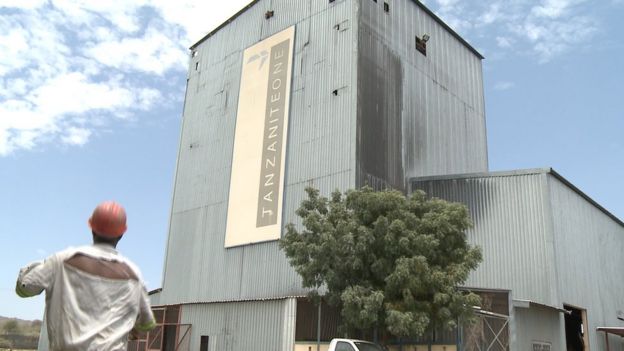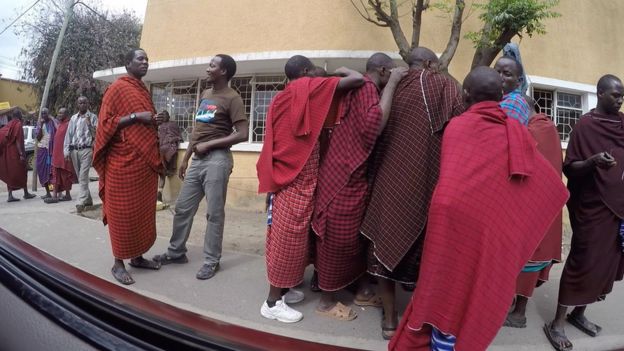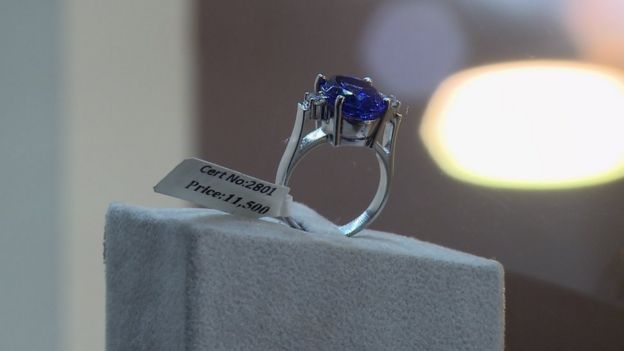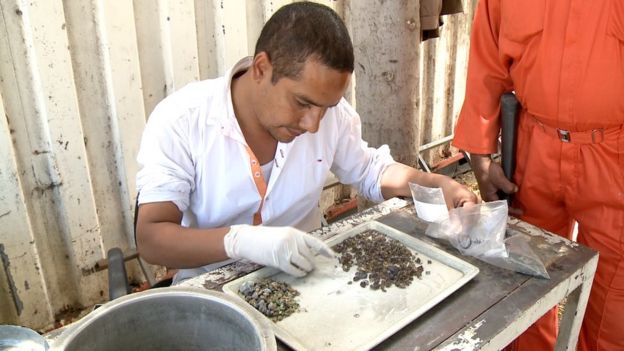
- 26 September 2015
- Africa
We arrive at Tanzanite One on a cool September morning.
The drive from the nearest town, Arusha, was not too long, but the last stretch on a gravel road littered with ditches made the hairs on the back of my neck stand up.
Once we got to the mine, we were given an induction and a quick briefing on the safety rules. After that we were off to the actual shaft, where we were allocated overalls, helmets and yellow plastic boots.
When I saw the contraption that would carry us 460 metres (yards) below ground, my excitement turned into fear.

Back-breaking work
The foreman referred to this square metal wagon as "the sink" partly because of the way it looks, but mostly because of the angular drop we would be making in it a few moments later.
Four of us could fit into it during a single trip down below.
We were the BBC crew together with the mine's chief geologist squashed underneath a steel bar, crouching as the wheels screeched into the dark pit.
A school bell tolled when we arrived on the site.
That was the signal the operators used for the pulley to either stop or go - quite basic.
By local standards Tanzanite One is said to be the most modern and mechanised mine in a region that exclusively holds vast reserves of tanzanite crystals, a mineral unique to Tanzania.
However inside the mine, we saw men working with shovels to load graphite into thick plastic bags. It is back-breaking work in hot and humid conditions.
The shortage of technological features makes it clear that Tanzanite One has limited capital investments.

A profitable operation?
The company was once listed on the London Stock Exchange, but today it is a privately owned company in a joint-venture with the State Mining Company of Tanzania.
Robert Grafen-Greany, affectionately called "GG" by the staff, is a British expatriate leading the prospecting and geology work being done on the mine.
He was showing us around the mine and then explained the simple economics of the tanzanite trade.
Even though this mine has the capacity to produce Tanzanite within a radius of 4km (2.5 miles), more exploration work is needed.
At present, it seems that potential investors need further convincing that this rare Tanzanian gem could lead to profitable investments in the future.
On the other hand, further exploration work cannot be done without more gemstones being sold, as that would boost the operating budget for the mine.
It's a catch-22 situation.
Nonetheless "GG" says that "historically it's been proven that it can be a profitable operation".
"Despite the difficulties. I think that's what's drawing in the investments."
The chief geologist also insists that irrespective of how sketchy things look on the surface, "in terms of regulation Tanzania has a solid mining code".
Instead, "the trickiest aspect of mining this deposit is the adherence to the code by other partners and stakeholders in surrounding mining towns".
This statement is a reference to the informal small-scale mines operating makeshift structures only a few hundred meters away from this big official mine.

Achilles heel
On the periphery of Tanzanite One is a network of small corrugated-iron huts, stone mounds and pits.
These are artisanal miners digging for tanzanite stones.
Most of them are individuals, both local and foreign, who have been granted mining licences.
Many are alleged to be smugglers.
It's a tricky situation, because small mines engender a culture of entrepreneurship and local ownership.
Mining reviews suggest that the informal network employs 10 times more workers than the big mining house, and provides work for the rural communities in the region.
The so-called smugglers however add a criminal element to a fledgling industry. They have been the Achilles heel along the tanzanite value chain.
Back in Arusha, brokers and gemstone dealers ply their trade openly on a main road.
They are noticeable by their resplendent red blankets typical of Maasai cultural costumes.
When we approach them for comment, they insist that they will only speak on condition of anonymity.
The man we meet looks to be in mid-30s, and says he's been "trading tanzanite for 10 years now".
"The major challenge we are facing here, is harassment from the government," he says.
It seems the government is trying to clamp down on the illegal trade in tanzanite stones.
Experts suggest that the black market has distorted the price.
It has also denied the government much needed royalties and sometimes led to violent crime in the sector.

Rarer than diamonds
Hasnain Sajan is the managing director of Tanzanite Experience. This is the retail arm of the mining industry.
They polish, design, sell and market tanzanite products mainly to customers abroad.
I ask him why it is that a gem which is claimed to be 1,000 times rarer than a diamond sells for lower prices and is less known.
Mr Sajan believes that with time, the tide will shift in favour of higher tanzanite prices due to increasing extraction costs.
"At the moment tanzanite is not found so deep under the earth but as it becomes exhausted we're having to go deeper," he says.
"Going deeper is more expensive, that means the prices will rise."
Currently global tanzanite sales amount to $50m (£33m) each year, whereas diamonds have been known to earn nearly $12bn in a single year.
That is clearly a concern.

'People don't know what it is'
However, what Mr Sajan finds more challenging is the lack of local awareness about tanzanite, despite Tanzania being home to this precious commodity.
He says "most people don't even know what tanzanite is".
In this regard, he urges the state to embark on a major marketing and publicity campaign.
His view is that the state should also be doing more to protect those who are legitimate miners of the stone.
"We need to have a fence in the area. We need to secure the area so that smugglers and criminals are kept away from the mines."
However, he concedes that perhaps the authorities are overwhelmed.
"The government is trying its best, but these are the small things they could do to make it better."
This is a sentiment shared across the industry from the range of people we met, be they mineworkers, brokers or retailers.
It may not be a simple fix but interventions in areas such as mine safety, security, formal brokering and better marketing of tanzanite, would ensure that Tanzania's most unique treasure is protected and sold for much more internationally.
No comments:
Post a Comment